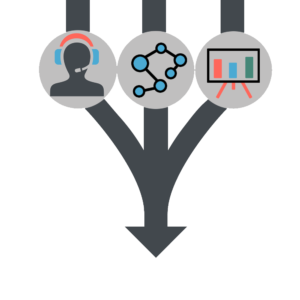Written by Fani Sánchez
Índice
You have finally made up your mind. You’re going to jump in the pool. You will put into practice what you do best – your product – at the disposal of others: you will open your own e-commerce!
You’re just starting out, we know. Your ecommerce is new and you are hardly known beyond your front door. But fear not. Throughout this article we will help you outline a social media strategy so that you don’t kill flies with cannons and optimize your resources to the maximum.
Social networks and e-commerce: the complete (or almost complete) love story
That e-commerce has clear advantages over physical stores is no secret: shop at any time of the day (no opening hours!), comfortably from home (and in your bathrobe!), access products that have not yet arrived in the physical store (just for me!) and avoid queues and crowds (poof!). But where is the social part? I want to show off my products, show them off or even exchange information with others before I decide to buy. For this, social networks are the perfect complement. And from the union of the two, Social Commerce is born.
Social Commerce
Social Commerce is the part of e-commerce that uses the media in which our target audience is present. to influence their purchasing decision. It is the social component added to e-commerce, whose relationship creates a perfect synergy for the sale: enjoy the advantages offered by e-commerce and share with friends and acquaintances your experiences, doubts or fears.
Social commerce is materializing as a trend based on “disintermediation” and the integration of the social component in the shopping experience.
Social media strategy for neophytes
This is the point at which more than one expert will emit a resounding rebuke of disapproval. Let me clarify: registering your brand on all social platforms is not the same as publishing and maintaining all social profiles. Registering profiles on all social networks is only a preventive measure, as you will not be the first or the last to have your name stolen.
From your website, you should link only those profiles that you keep updated and use regularly. If you do not use Facebook, for example, you can register the page and leave it in private mode. Other platforms such as Pinterest, by their nature, require a minimum maintenance beyond which a profile is considered a “decent image” of your brand. You can always dedicate a couple of days to optimize it and then leave it on standby until you decide to integrate it into your Social Media strategy (and depending on your sector, it will be advisable to do so).
Finally, remember to register all networks with a corporate email not linked to any person. It is not advisable to have them registered in an employee’s personal (even if corporate) e-mail. Over time, the management of your social networks may change hands or become a task carried out by more than one person. Registering profiles with a specific corporate account will save you unnecessary time in changing passwords or emails.
We know there is a social network for every user profile, so the next step is for you to locate them. But where to start?
- General social networks such as Facebook, Twitter, Tuenti or Google+. Each one of them usually congregates an audience of a certain age or interest.
- Social networks focused on Business to Business such as LinkedIn. This type of social networks will be especially interesting if your e-commerce is a manufacturer or is dedicated to the sale or distribution of goods.
- Vertical social networks, specialized in a particular topic. For example, if you have a pet supplies store, you will probably be interested in being present in networks such as Mascotea or Facepets.
Choose from these broad categories which ones best fit your target audience. You should optimize, keep alive and link from your website only those profiles:
- Where your target audience is located: the opposite would be a waste of your capital.
- That you can keep active and attended according to your resources: just being there for the sake of being there not only does not make sense, but it will also give you a bad brand image.
Register your company in all the social networks you consider and with a corporate account (prevention), but use only those profiles where your target audience is and that you can keep updated (logic).
Choose your tone of communication
You must have a clear idea of the tone of your communication: close, serious, informal, casual, casual, fun? Choose the tone that best represents what you want to convey with your products or services and make sure it is maintained over time. Your social profiles should be the voice that unifies your message. If your community manager changes over time, your users should not notice it.
If you have an e-commerce business, you must understand that your website is your showcase and sales tool. We recommend creating synergies between your site and social platforms (the natural habitat of your customers), in different ways.
- Social share buttons. Installing these buttons on your product cards allows you to share them on the main social networks. Maybe someone is thinking of buying the tablet you have on offer, but needs the opinion of their friends. Make it easy. In addition to getting traffic to your website, you can get valuable information from this source.
- Email marketing. Ask your consumers to rate you or your products on Facebook or Google+ through your email marketing strategy. Incentivize them with discounts or promotions on their next purchase. You can send them an email after their purchase, in a time frame that gives them space to try the product but not so long that they forget about other relevant factors to value in your service such as shipping times, etc.
- Visible social icons. The footer or header are the most common places to place social buttons. Make sure they integrate with your web design but are sufficiently eye-catching. Also add a clear title, indicating where it leads to.
- Rich formats for social networks. At the programming level, some features will help you present your products or services in a visually more attractive way to your users that can make the difference between a sale and a simple display on their walls. Use OpenGraph for Facebook, Twitter Cards for Twitter and Rich Pins for Pinterest.
Your customers are waiting for you on social networks, where they share their experience and opinions, where they ask for advice and express their preferences. Therefore, you should make it as easy as possible to share that experience without being intrusive.
But there is no point in having a social website if you don’t know how your users behave within it. Investigate what proportion of your users come from social channels, which pages they go to, their conversion rate, the pages they leave the site for, their demographics, if you have a higher percentage of returning or new users…
Social traffic analytics on your website will help you take corrective action on your social media actions.
Social networks as a customer service channel

- Answer your customers and users within 24 hours. Shorten this time whenever possible.
- Do not refer complaints or questions to third party departments unless strictly necessary. Users do not want to repeat the history of switchboards and waiting times. If you have to consult other departments, the cost of extra time or effort should never be borne by the user.
- Always be clear, respectful and empathetic. Your customers will appreciate it.
Shorten times by creating action protocols

- Negative comments about your brand in your profiles.
- Doubts and complaints from customers or potential customers.
- Commercial contacts.
- Human resources contacts.
In these protocols you should define:
- The tone of the communication.
- The skeleton of the discourse in each casuistry.
- The persons designated for decision making according to the type of consultation.
- Your maximum performance times and those of third departments.
- The performance margins of your Community Management team.
- Palliative measures if necessary.
It is important that each actor involved in these processes is aware of his or her role in the process.
Physical store: tips to optimize your integration
If in addition to your e-commerce you have a physical store, you should consider some more aspects to increase your visibility.
There are some more local social networks that you should be aware of if you have a physical store
- Google+ Local: don’t forget to register your business in Google+ Local. You can connect your listing with Google Maps and make it easier for thousands of users to find your store, link them to your website and appear in Google Maps search results. A must-have.
- Yelp: although it is not a social network generally widely used in Spain (it is in large population centers such as Madrid or Barcelona), it is a good option in other countries. Users come here to consult other users’ opinions or to review physical stores. You can create your business card and interact with the community.
- Foursquare: although the use of this social network plummeted after its drastic change of strategy and design in mid-2014, there are still those who use this App as a reference when visiting stores or restaurants. Having your company profile on this social network is a must.

You can also try the promotion in reverse: advertise events or special offers in the physical store through your social profiles.
In conclusion…
As you can see, the management of social networks in a new e-commerce, is not different in general lines from the management of networks for any other business or corporate website except in the Social Commerce part.
The vast majority of shoppers are socially influenced by the recommendations of friends or simply other shoppers or users. We are designed to express our preferences and share them with others and it is proven that the probability of purchase increases when we have a connection with the brand.
Properly integrate social networks into your e-commerce strategy, use them as another sales channel and ensure your success. Increasing profits is only the beginning of a long road.

